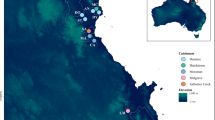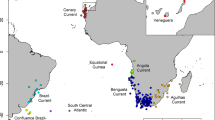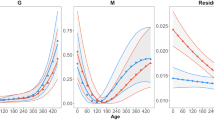Abstract
An important goal in the study of evolution is to determine the occurrence, causes and possible micro-evolutionary consequences of selection in natural populations1–3. Darwin's finches (Geospizinae) are suitable organisms for investigation because their morphological traits are highly heritable4, and they live in a climatically variable environment (Galápagos Islands)5,6. It has been suggested that selection fluctuates in direction and intensity, favouring different morphological optima in different years7, because strong annual variation in rainfall causes changes in food supply composition7,8. This suggestion has been supported in part by studies of the medium ground finch, Geospiza forth, on the island of Daphne Major, which have shown that large adult size is favoured under drought conditions, when the overall food supply is low and large hard seeds are disproportionately abundant8,9. Here we document a reversal in the direction of selection following the opposite climatic extreme, and demonstrate the connection between oscillating selection and fluctuations in food supply.
This is a preview of subscription content, access via your institution
Access options
Subscribe to this journal
Receive 51 print issues and online access
$199.00 per year
only $3.90 per issue
Buy this article
- Purchase on Springer Link
- Instant access to full article PDF
Prices may be subject to local taxes which are calculated during checkout
Similar content being viewed by others
References
1. Lande, R. & Arnold, S. J. Evolution 37, 1210–1226 (1983). 2. Endler, J. A. Natural Selection in the Wild (Princeton University Press, 1986). 3. Grant, P. R. Ecology and Evolution of Darwin's Finches (Princeton University Press, 1986). 4. Boag, P. T. Evolution 37, 877–894 (1983). 5. Grant, P. R. & Boag, P. T. Auk 97, 227–244 (1980). 6. Grant, P. R. Am. Orn. Un. Monogr. 36, 471–483 (1985). 7. Grant, P. R., Grant, B. R, Smith, J. N. M, Abbott, I. J. & Abbott, L. K. Proc. natn. Acad. Scl U.S.A. 73, 257–261 (1976). 8. Boag, P. T. & Grant, P. R. Science 214, 82–85 (1981). 9. Price, T. D., Grant, P. R, Gibbs, H. L. & Boag, P. T. Nature 309, 787–789 (1984). 10. Gibbs, H. L., Grant, P. R. & Weiland, J. Auk 101, 872–874 (1984). 11. Gibbs, H. L. & Grant, P. R. Ecology 68 (in the press). 12. Cane, M. A. Science 222, 1189–1195 (1983). 13. Price, T. D. Ecology 68 (in the press). 14. Grant, P. R. Anim. Behav. 29, 785–793 (1981). 15. Boag, P. T. & Grant, P. R. Biol. J. Linn. Soc. Lond. 22, 243–287 (1984). 16. Price, T. D. & Grant, P. R. Evolution 38, 483–494 (1984). 17. Fleischer, R. C. & Johnston, R. F. Nature 298, 747–749 (1982). 18. Price, T. D. Am. Nat 123, 500–518 (1984). 19. Grant, B. R. Evolution 39, 523–532 (1985). 20. Monaghan, P. & Metcalfe, P. Evolution 40, 1096–1099 (1986). 21. Schluter, D. & Smith, J. N. M. Evolution 40, 221–231 (1986). 22. Grant, P. R. & Price, T. D. Am. Zoo/. 21, 795–811 (1981).
Author information
Authors and Affiliations
Rights and permissions
About this article
Cite this article
Gibbs, H., Grant, P. Oscillating selection on Darwin's finches. Nature 327, 511–513 (1987). https://doi.org/10.1038/327511a0
Received:
Accepted:
Issue Date:
DOI: https://doi.org/10.1038/327511a0
This article is cited by
-
The consequences of craniofacial integration for the adaptive radiations of Darwin’s finches and Hawaiian honeycreepers
Nature Ecology & Evolution (2020)
-
Morphological trophic variation of the cyprinid Megalobrama pellegrini (Tchang, 1930) with different keratinized beaks from upper reaches of the Yangtze River, China
Environmental Biology of Fishes (2020)
-
Discovery of species-wide tool use in the Hawaiian crow
Nature (2016)
-
Many-to-Many Mapping of Phenotype to Performance: An Extension of the F-Matrix for Studying Functional Complexity
Evolutionary Biology (2014)
-
Does selection intensity increase when populations decrease? Absolute fitness, relative fitness, and the opportunity for selection
Evolutionary Ecology (2013)
Comments
By submitting a comment you agree to abide by our Terms and Community Guidelines. If you find something abusive or that does not comply with our terms or guidelines please flag it as inappropriate.



